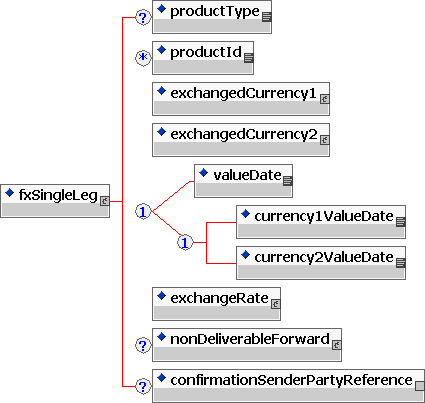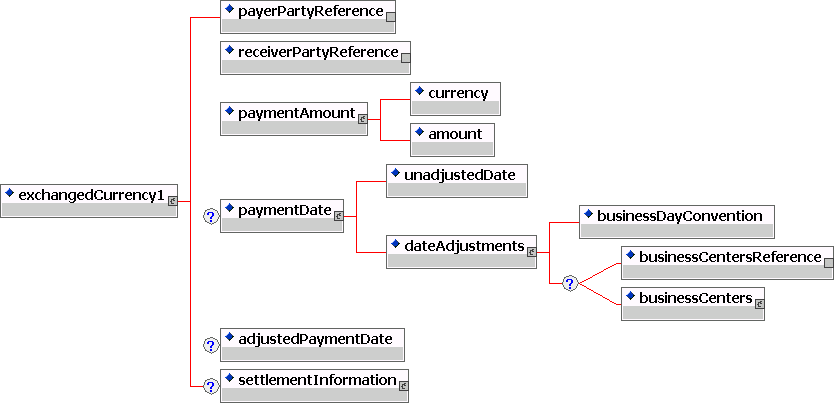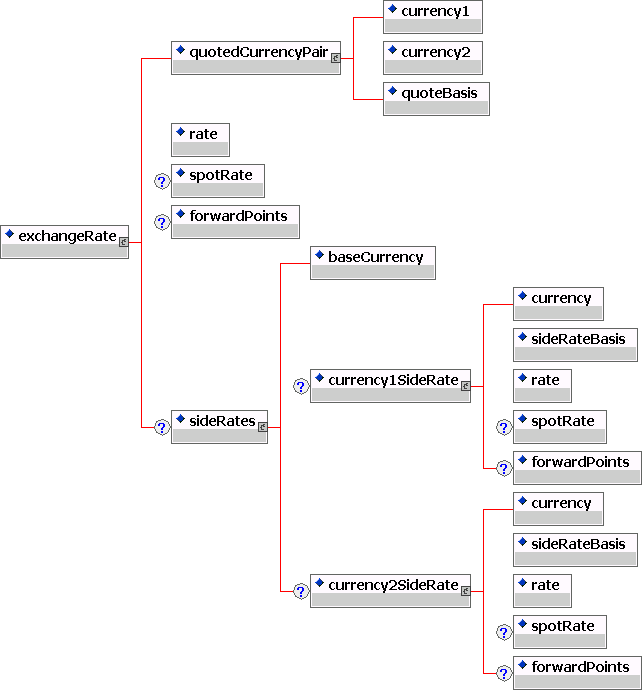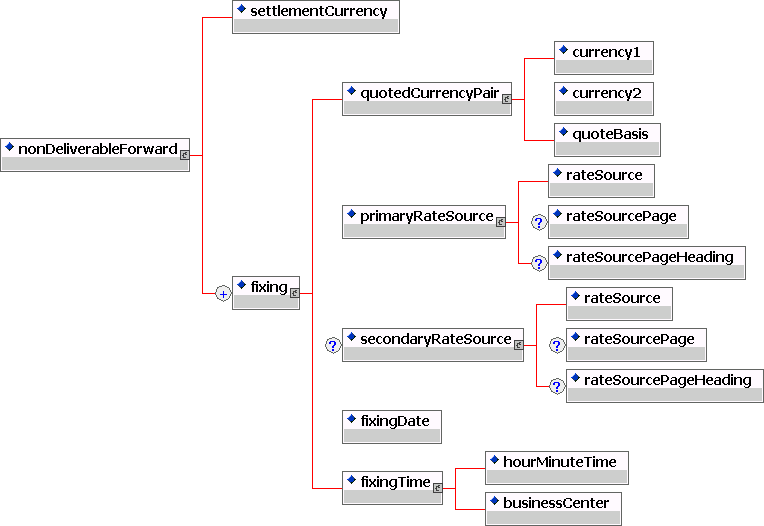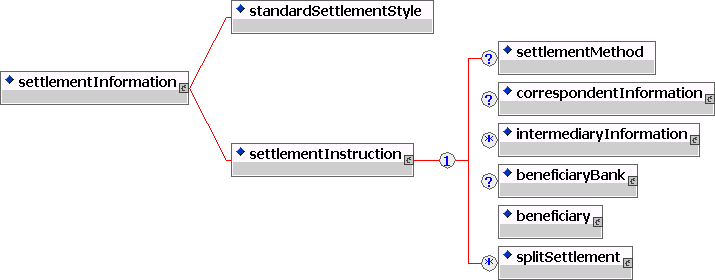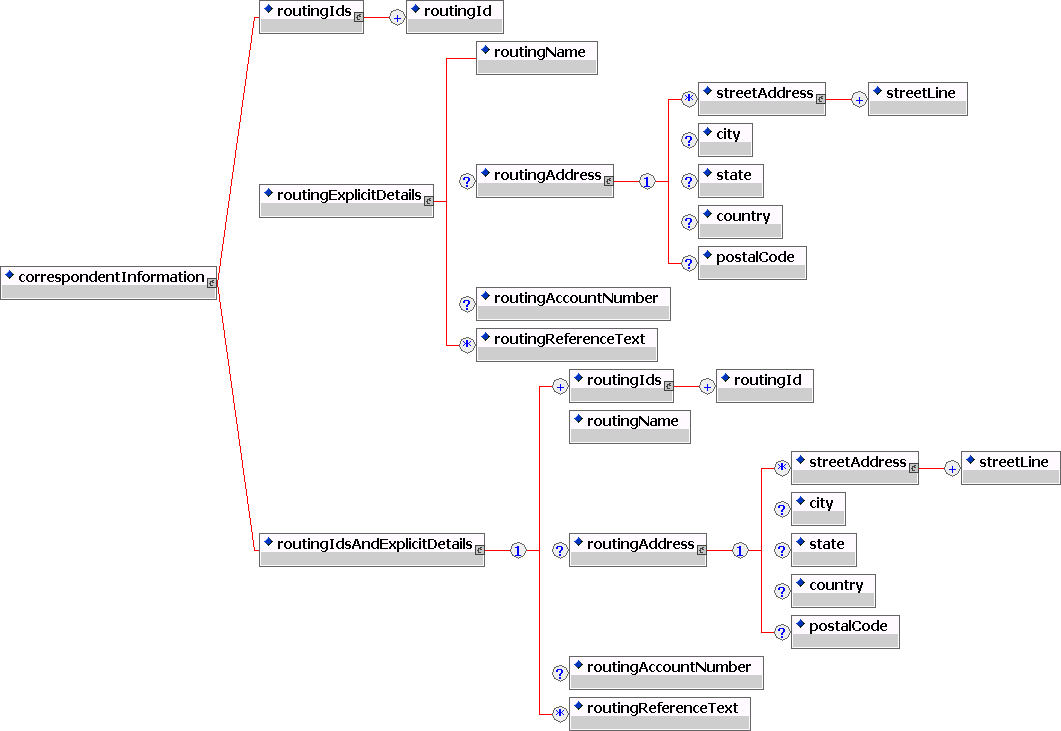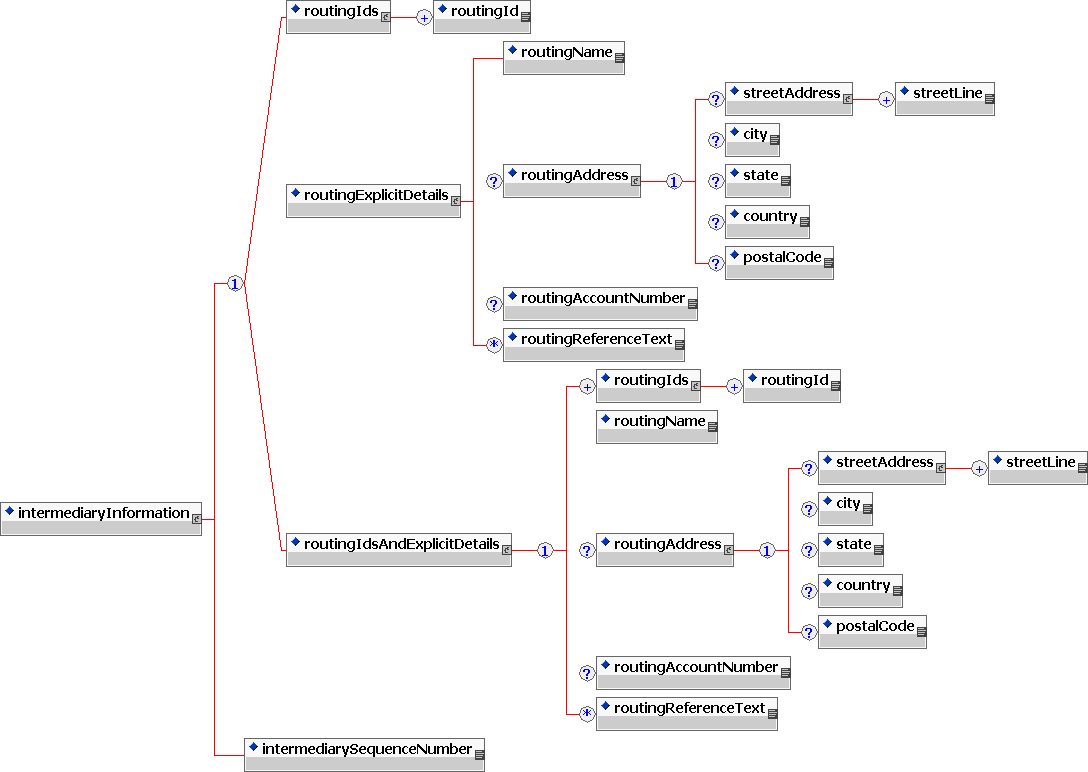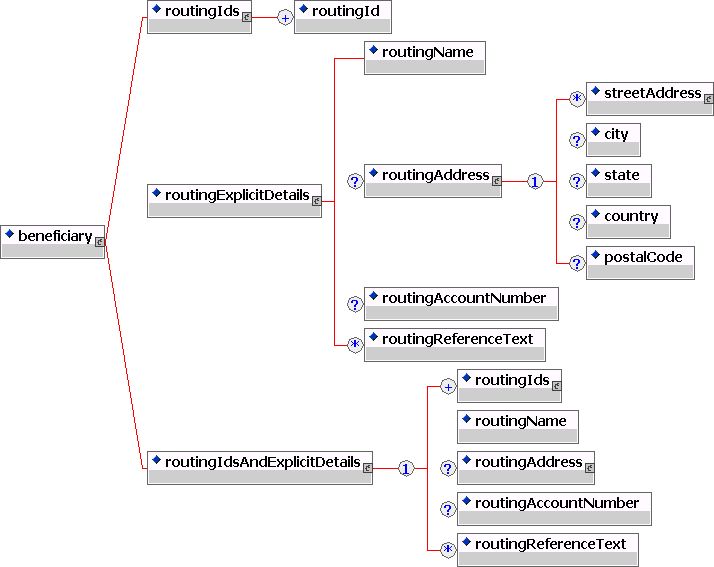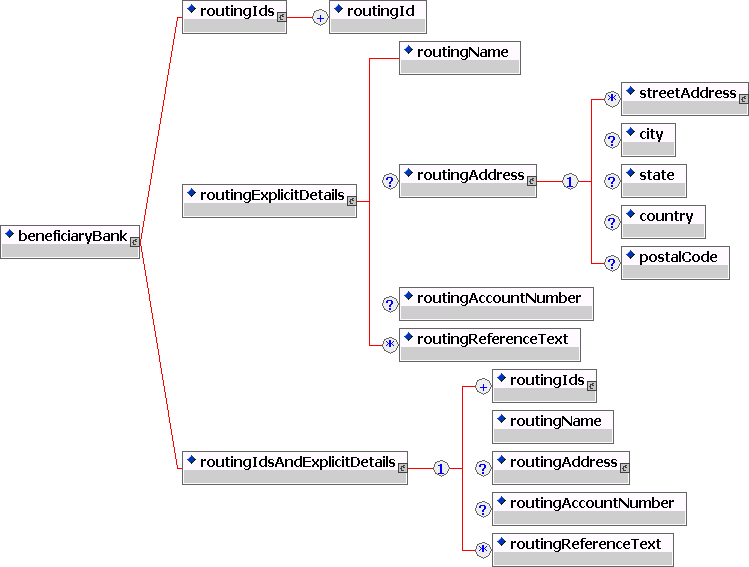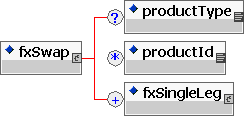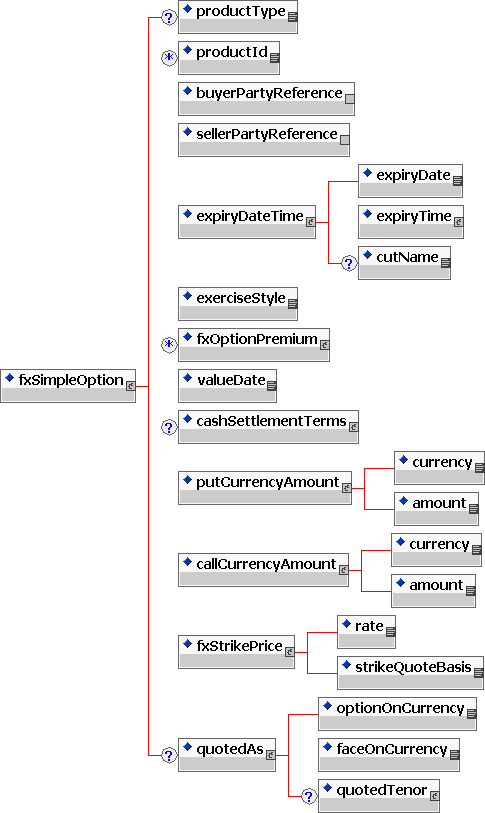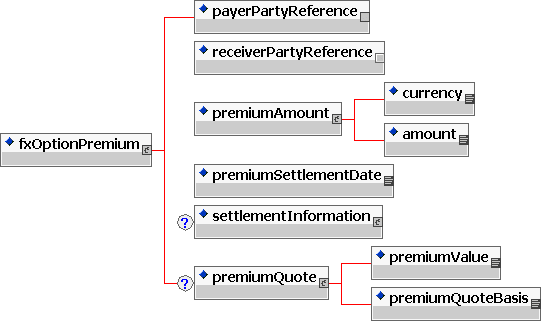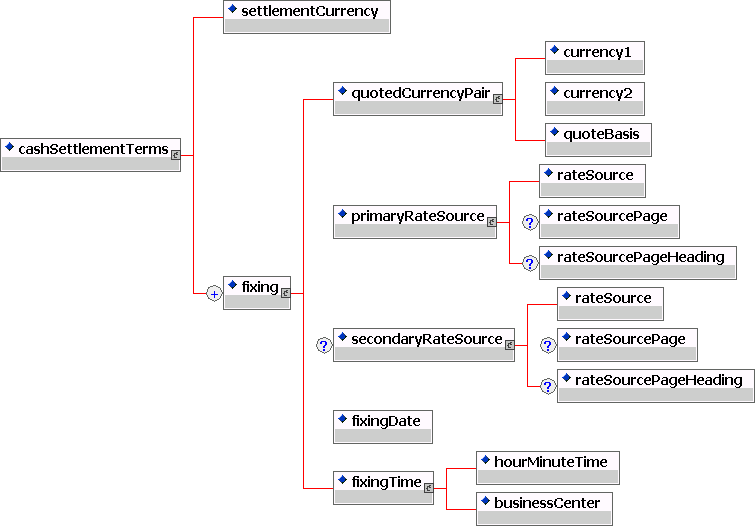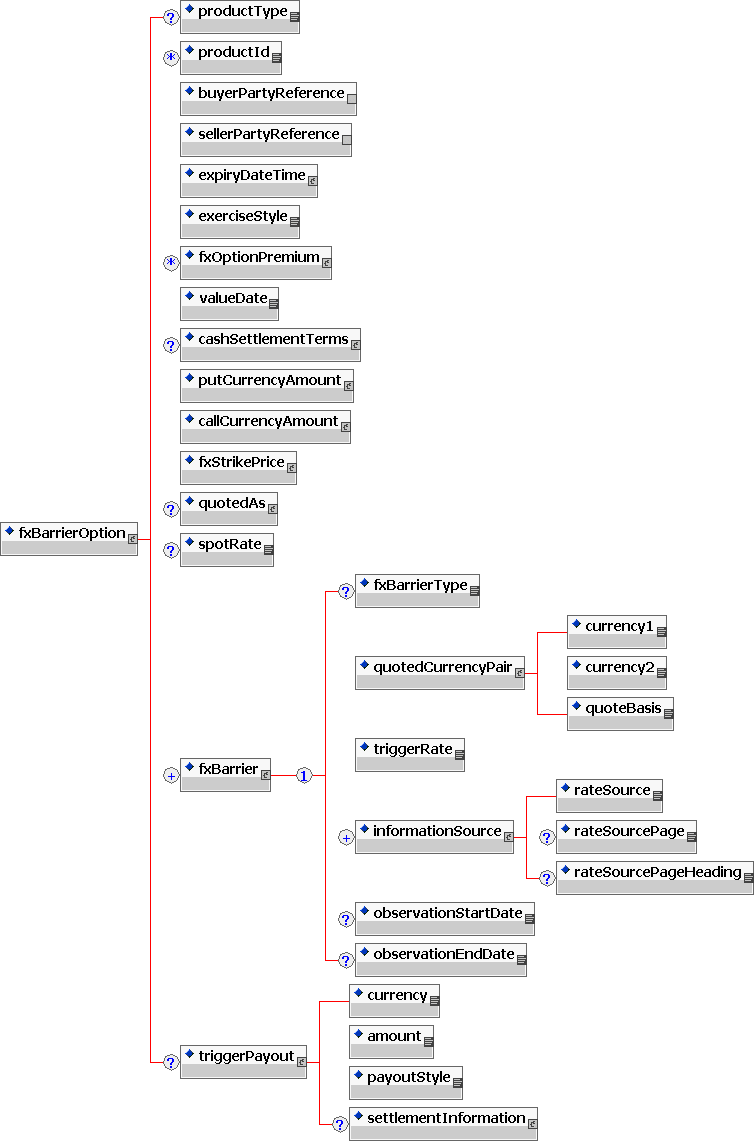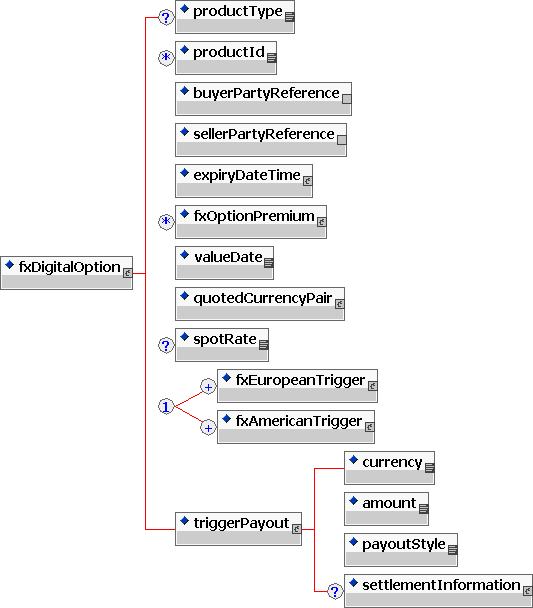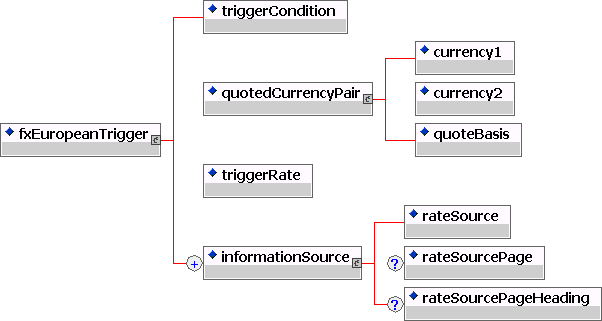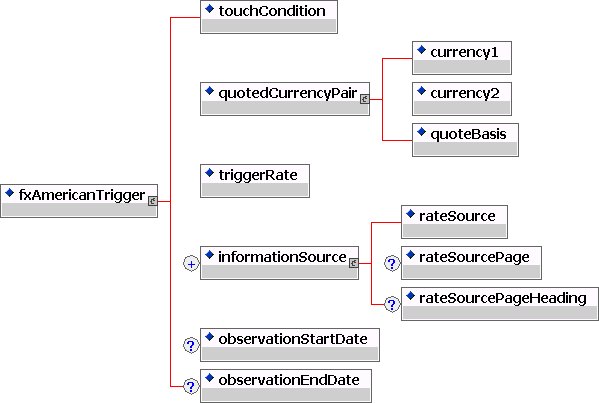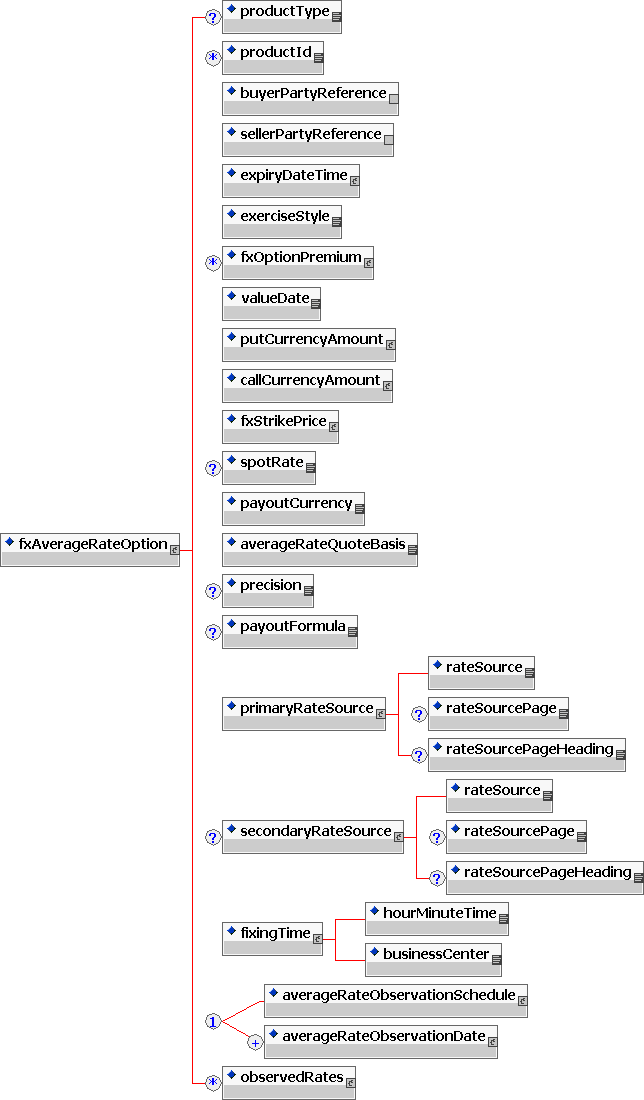7.1 Foreign Exchange Spot and Forward
Foreign exchange single-legged instruments include spot and forwards. fxSingleLeg contains two instances of the exchangedCurrency component (the first currency and the second currency), either a single value date component for the trade or an optional value date per exchanged currency, a single instance of the exchangedRate component, and an optional nonDeliverableForward component.
The simple FX transaction contains two currencies which are exchanged between parties. The characteristics of each currency exchange: the currency, the amount, and optionally settlement instructions, are described in the exchangedCurrency structure. An optional payment date is allowed per currency, if there is a requirement to provide for date adjustments for each currency based upon business day conventions to accommodate unscheduled holidays.
The rate of exchange is required for a foreign exchange trade. The rate of exchange includes a reusable entity (FpML_QuotedCurrencyPair) that describes the underlying composition of the rate: the currencies and the method in which the rate is quoted. The actual trade rate is required, but other rate information such as spot rate and forward points are also accommodated. For non-base currency trades, side rates (or rates to base) are provided for.
Non-deliverable forwards are catered for within the conventional FX single leg structure by including an optional non-deliverable information structure. This contains identifies the agreed-upon settlement currency and describes the fixing date and time, as well as the settlement rate source that the fixing will be based upon. The non-deliverable structure is shown below.
Significant effort has been spent in the development of FX to incorporate the appropriate information required for trade confirmation and settlement. An optional settlementInformation structure has been included for each exchanged currency. This can be used in a variety of ways: not at all, flagging a trade for standard settlement, flagging a trade for settlement netting, or specifying the detailed settlement instructions for that particular currency flow.
If the specific settlement instruction is included, then this is broken out into correspondent, intermediary, and beneficiary information. This includes the identification of the routing mechanism (e.g., SWIFT, Fedwire, etc.) that the trade will settle via and the id and account that the trade will settle via. Routing can be handled either via purely a routing id (e.g., SWIFT code), routing details (a customer name, address, and account number), or a combination of routing id and details. The following diagrams show the correspondent, intermediary, and beneficiary structures.
Split settlement is also accommodated. Split settlement will mean that there will be multiple beneficiaries associated with a single trade, where the payment amounts are broken down between beneficiaries. The following diagram shows how this has been modeled:
Foreign exchange swaps are a very simple extension of FpML_FXLeg, whereby the FX swap is simply multiple legs. A standard FX swap contains two legs, whereby the second leg has a value date that is greater than the value date on the first leg. There are a variety of different types of FX swaps in the marketplace: standard (round-amount) swaps, overnight swaps, unequal-sided swaps, forward-forward swaps. Therefore, all of the features that are available within a standard spot or forward trade (described previously) can be utilized in describing an FX swap as well.
Foreign exchange simple options include standard European and American options. These are commonly referred to as "vanilla," or non-exotic, options. fxSimpleOption identifies the put currency and amount and call currency and amount, as well as the exercise style and premium information. The premium is structured similar to an exchanged currency for a conventional FX trade, where optional settlement information for the premium can be attached. In addition, there is an optional quotedAs structure that contains information about how the option was originally quoted, which can be useful. Below are the structures for a conventional FX OTC option.
Non-deliverable options are also supported by including the FpML_CashSettlement, which is the identical structure used within non-deliverable forwards.
A conventional option except that it is changed in a predetermined way when the underlying trades at predetermined barrier levels. A knock-in option pays nothing at expiry unless at some point in its life the underlying reaches a pre-set barrier and brings the option to life as a standard call or put. A knock-out option is a conventional option until the price of the underlying reaches a pre-set barrier price, in which case it is extinguished and ceases to exist. Barrier options have both a strike price and a barrier price.
An optionalbarrierTypeScheme is used to allow for differentiation between knockin, knockout, reverse knockin, and reverse knockout options. One or more barriers are supported. The reference spot rate, while optional, is recommended, as it determines whether the option need to go up or down (or is "out-of-the-money" or "in-the-money") in order to hit the barrier. Additionally, the payout is utilized to accommodate rebates when a barrier is hit. Below are the structures for an FX OTC barrier option.
The terms binary and digital are not clearly defined in the FX markets and can occasionally be synonymous. This is used to define an option that has a discontinuous payout profile. It typically pays out a fixed amount if the underlying satisfies a predetermined trigger condition or else pays nothing. Unlike the standard option, the amounts quoted are the payout amounts as opposed to a notional underlying amount.
Digital options typically are defined as being European, meaning the observation occurs only if the spot rate trades above (or below) the trigger level on expiry date. The two examples that have been included in the specification are the digital and the range digital.
Binary options, on the other hand, are more like American options, meaning that the payout occurs if the spot rate trades through the trigger level at any time up to and including the expiry date. The four examples that have been included in the specification are the one-touch, no-touch, double one-touch, and double no-touch binary options. Below are the structures for FX OTC binary and digital options.
Foreign exchange average rate options (sometimes referred to as Asian options) are options whose payout is based upon the average of the price of the underlying, typically (but not necessarily) over the life of the option. Average rate options are popular because they are usually cheaper than conventional options because the averaging process over time reduces volatility.
fxAverageRateOption allows for either a parametric representation of the averaging schedule (e.g., daily, 2nd Friday, etc.), utilizing the same rolling convention schemes as utilized within the interest rate derivatives area. Alternatively, each specific averaging period can be identified, along with a specific weighting factor for that period. In addition, average rate options on occasion, when struck, already have agreed-upon rate observations in the past; the structure accommodates this as well.
The term deposit is an agreement between two parties to enter into a financial contract. Similar to a forward rate agreement, a term deposit is contained within a single component and contains no interim interest payments. It is an on-balance sheet transaction that pays interest at maturity based upon an agreed interest rate. While the term deposit instrument is technically an interest rate product, it is included within the FX section of FpML because many institutions that utilize FX transactions also conduct short-term deposits in their respective portfolios to fund foreign currency requirements.
Although there are a number of structured deposits that are occasionally transacted in the marketplace, including deposits with amortizing structure, rateset schedules, and periodic interest payment or interest recapitalization schedules, or even deposits that are denominated in one currency but pay interest in another currency, those types of transactions represent a significant minority of the number of deposits dealt in the wholesale financial marketplace. Therefore, the term deposit structure is intentionally very simple to accommodate the simple yet highly liquid deposit instruments.
Note that both the start date and maturity date of the term deposit is negotiated up front and are typically of short duration, so the dates of these instruments are fixed. Any unforeseen holidays will generally cause for renegotiation of the contract. Therefore, similar to FX instruments, there are no allowances for date adjustments.
One or more financial instruments, of any sort that are supported by the FpML specification, can be combined to form what is called a strategy. This can include various a package of the same or different asset classes in a single trade. Typical examples of this would include option packages (e.g., straddles, strangles) or a delta hedge (FX OTC option with spot risk hedged by FX spot deal). Additionally, other asset classes can be combined in a strategy (e.g., interest rate swap with FX, etc.).
